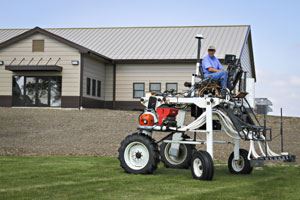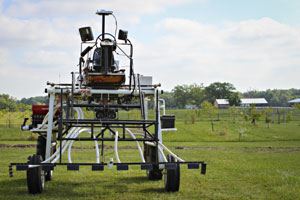|
To Pastures And Beyond
John Lory’s ‘Skylab’ Looks To The Future Of Forage Management
COLUMBIA, MO.
It looks like something from a science fiction tale or an other-world exploration unit. Instead, it is one of the latest pieces of equipment University of Missouri researchers use to study pastures.
“We call it Skylab,” said John Lory, associate professor of plant sciences at the MU College of Agriculture, Food and Natural Resources. “It is a research tool that gives us a leg up on past technologies to easily test forages and how nitrogen can affect plant growth.”

Extension Associate Professor John Lory talks about his study with a high-crop
style tractor mounted with sensors to more accurately distribute nitrogen to row crops and forages.
Photos by Kyle Spradley | © MU College of Agriculture, Food & Natural Resources

The 2013 Forage Systems Research Center Field Day was held on Sept. 25
at the center near Linneus, Mo. Several dozen students from
Linn County high schools joined several producers for a day of
educational tours ranging from managing field edges for wildlife
to automated weather monitoring, grazing novel endophytes and
ways to reduce hay waste. A demonstartion of an UAV also
peaked the interest of visitors.
In the spring of 2013, Lory began to assemble different sensors on a highboy tractor thanks to a grant from the Natural Resource Conservation Service and support from the MU Division of Plant Sciences. The machine with 6 feet of ground clearance is more commonly used for spraying crops, but Lory is looking to do spatial management studies of pastures at CAFNR’s Forage Systems Research Center in Linneus to give Missouri farmers a better understanding about what is going on in their pastures.
Futuristic Technology
The unit is used to test a variety of sensors for use in monitoring pastures. A sonic sensor is being used to measure forage height. Sonic senors work similarly to radar in that a signal is sent out and the sensor calculates the time interval it took to receive the echo to determine the distance to an object. This allows Lory to monitor pasture growth.
Spectrophotometers also were added to monitor the color of a plant’s leaves. The current sensor measures greenness of the crop, providing the researcher data on plant nitrogen status. Similar technology has been used on other commercial crops such as corn and wheat, but few algorithms have been developed for managing forages.
“In the past forage studies required harvesting sections of pastures or having mounted sensors on tractors or ATV’s to study crops and forages,” said Lory. “But the problem with that is it impacts the site. With this machine, we can easily go over a study site multiple times without having an impact on the forage in the plots. It has the high clearance and wide wheel base to allow us to more efficiently study what is going on out there in our pastures.”
Skylab also is equipped with GPS units to precisely mark coordinates where data is collected. Its auto-steer capabilities allow the researchers to plot out a path in a pasture to replicate data collection more accurately over time.
“We want to track the small increments in a pasture so we can see the effect of a manure or urine patch on plant growth and to track growth repeatedly throughout a regrowth cycle,” said Lory. “I want to know how does nitrogen affect the rate of plant growth to give our farmers more accurate management tools. This will allow us to answer questions about if I put nitrogen on a field at this time of year, how fast does this express itself?”
The Livestock Impact
Farmers have always known that nitrogen affects growth, but just how rapidly has always been a question. Having a better understanding of forage growth can truly impact livestock and grazing practices.
The research also is looking at how livestock can play a role in forage growth. “Thanks to the resources at the Forage Systems Research Center we are able to allow cattle to graze a pasture we are studying with Skylab to see how livestock play a role in forage growth,” added Lory.
What the Future Holds
This study is part of a multi-year project that Lory hopes will to continue to understand more about forages and how nitrogen affects the pasture. In the future, he hopes systems with these sensors will be more readily available for farmers.
“If farmers could upload that data they collect out in the pastures to an online database and get a readout of how much nitrogen needs to be applied, that would be an invaluable tool to have for our Missouri farmers,” he said. “I would hope in the next two to five years that will be a reality thanks to research we are doing now.”
The Forage Systems Research Center works to improve the quality of forage grass and determines its best use. An early promoter of management-intensive grazing, it supports the agriculture industry through courses in rotational grazing, cattle management and the economics of beef and forage. The interactions of cattle, plants and soil are necessary in understanding cause/effect relationships in beef/forage systems. Since 1990, more than 3,000 farmers and educators from several states have attended the three-day intensive Missouri Grazing School.
For information about the work done at Forage Systems Research Center visit http://aes.missouri.edu/fsrc/.∆
|
|